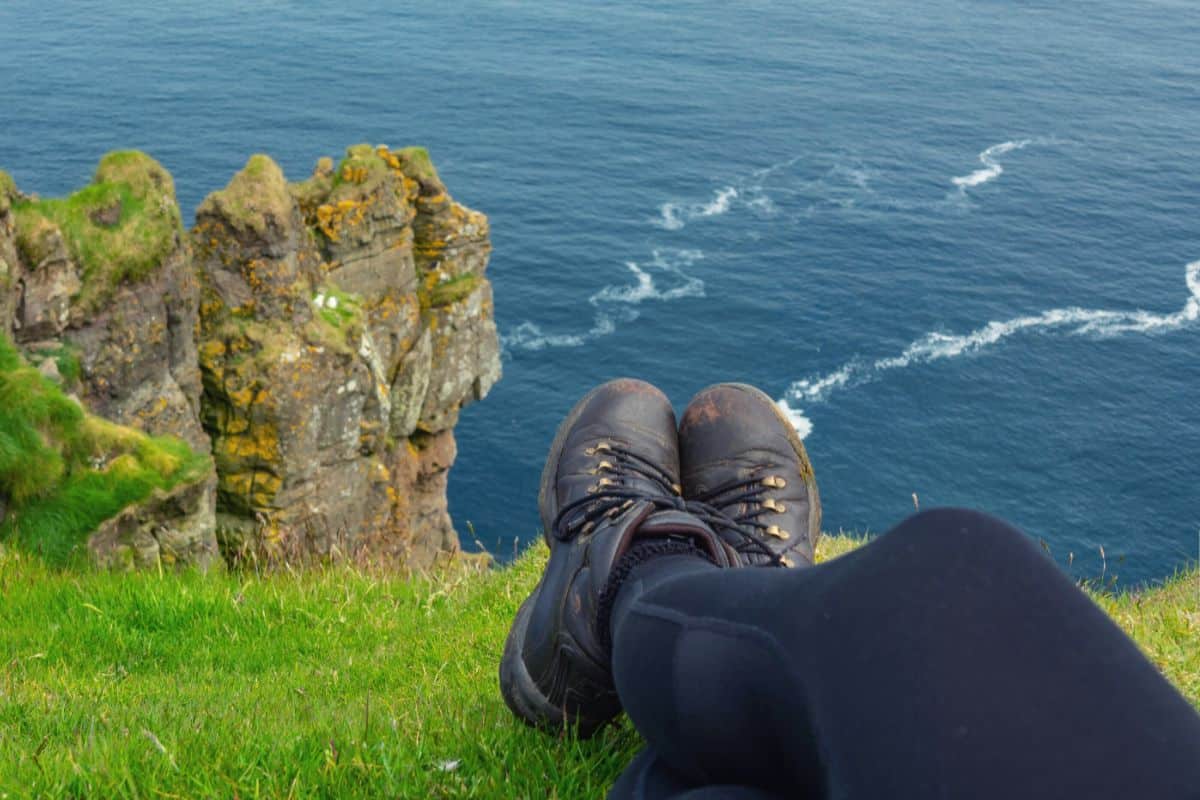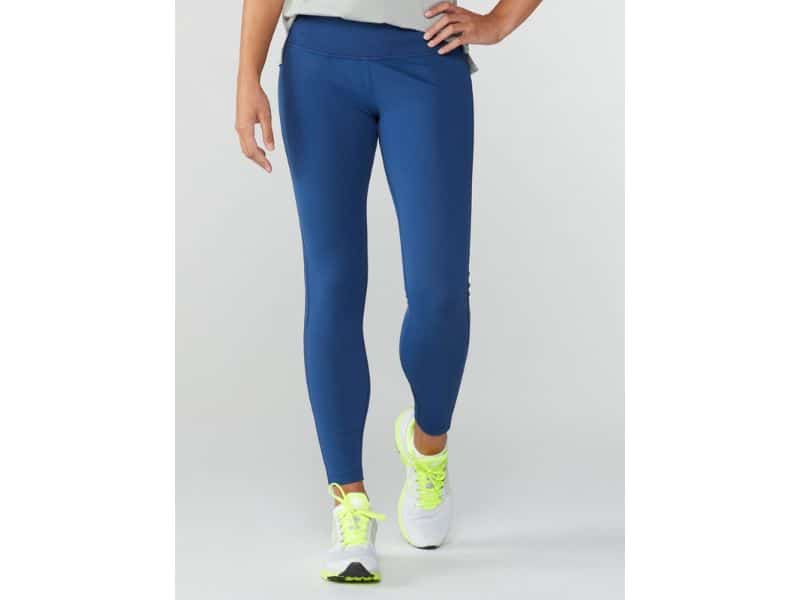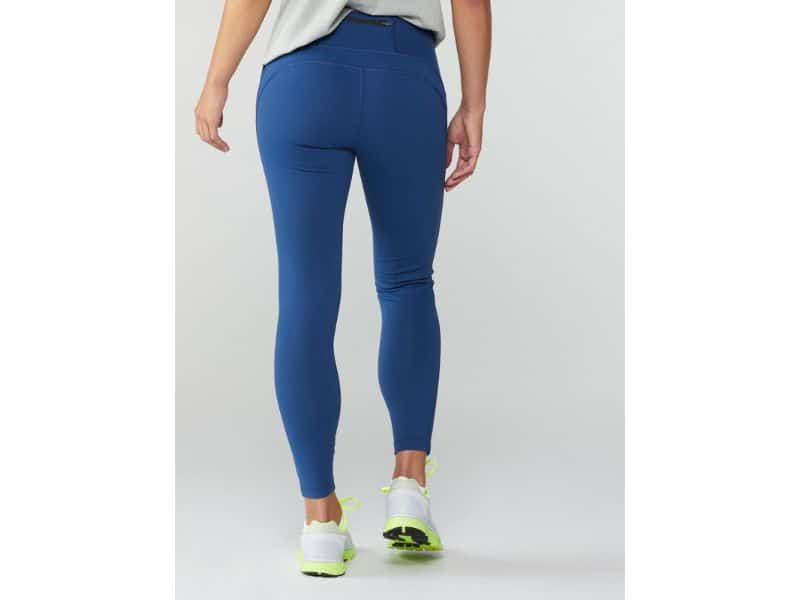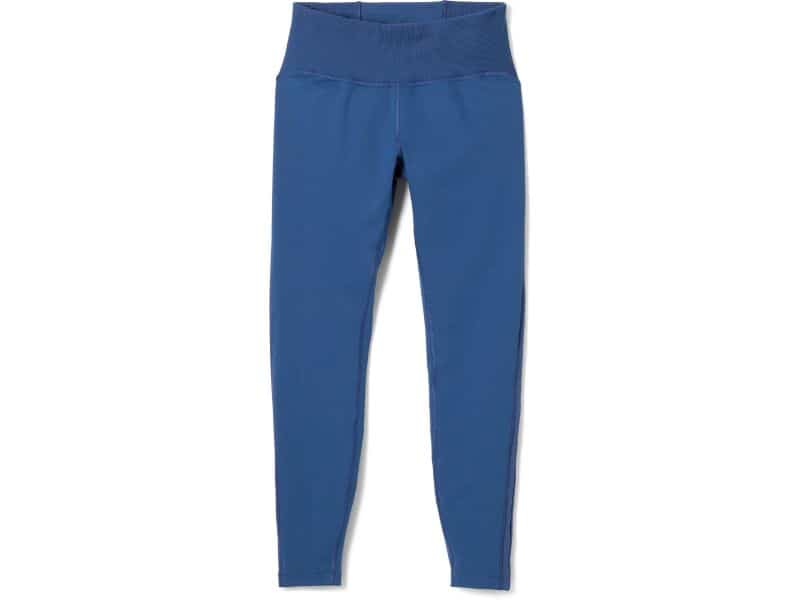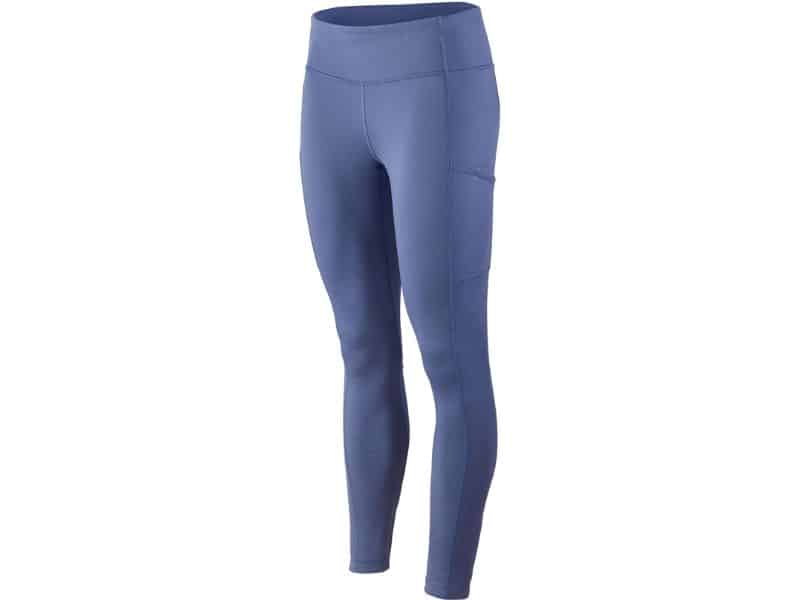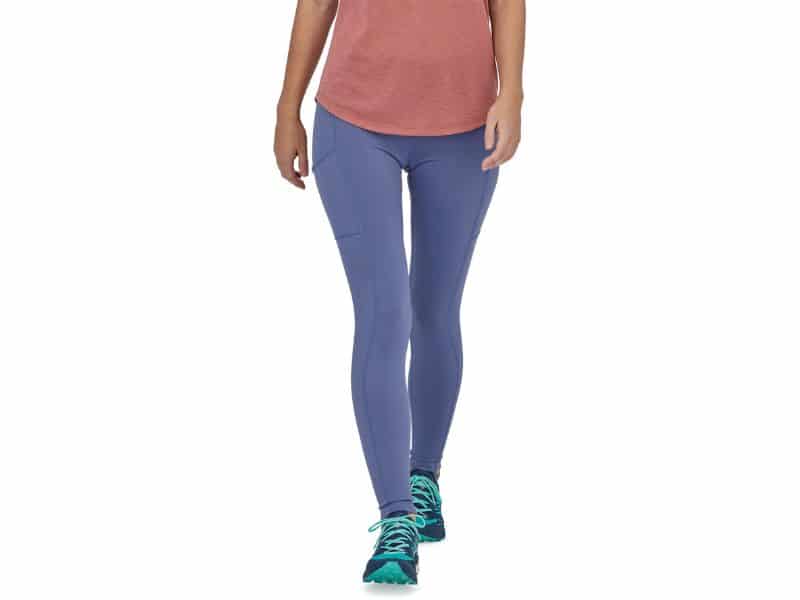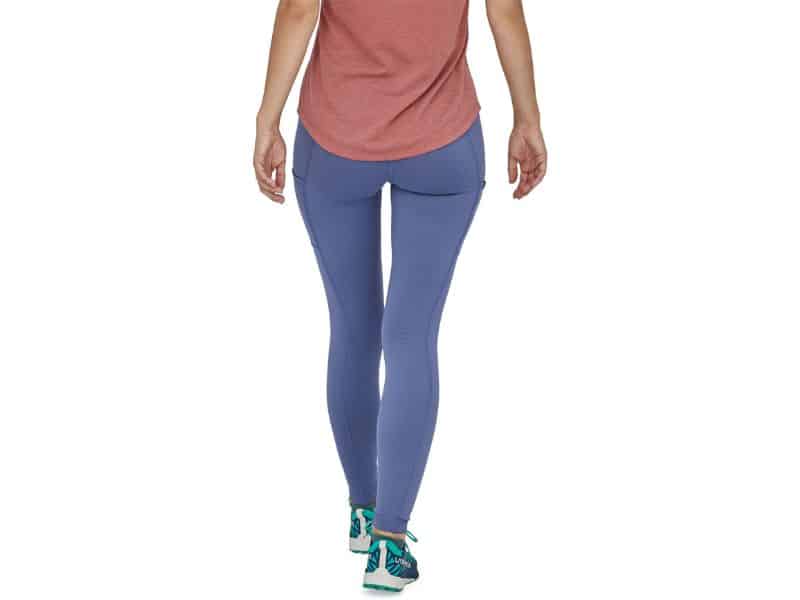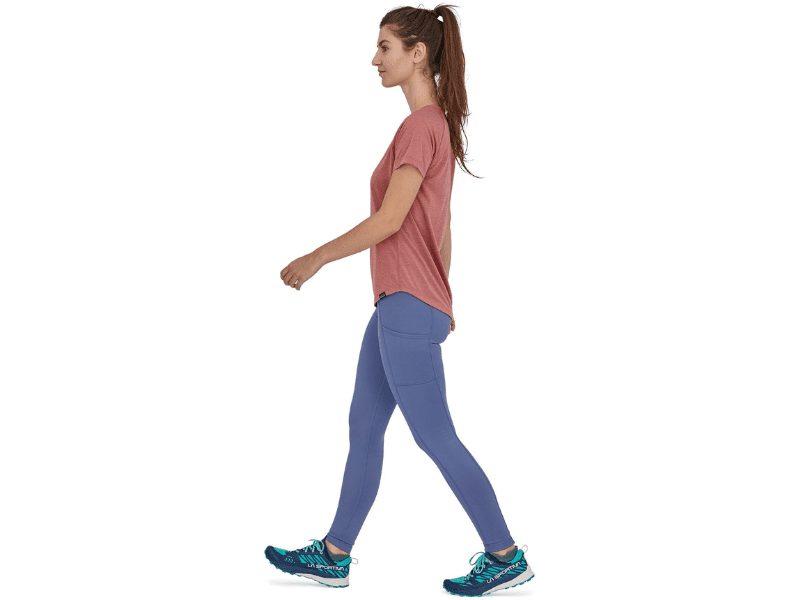In recent years, leggings have become en-vogue with hikers everywhere – and with good reason. They’re mobile, breathable, affordable, versatile, chafe-resistant, and a darned sight more comfortable than the comfiest hiking pants out there.
In this post, you’ll find 9 pairs of awesome leggings that earned top marks in our annual review. From ultralight summer options to beefier, merino wool models ideal for winter hikes, our list has it all!
At the bottom of our reviews, we’ve also included a short, BS-free guide on how to choose the perfect pair of leggings for your body shape and adventure style.
Table of Contents
Top Choices by Category
Budget: Eddie Bauer Trail Tight and REI Co-op Active Pursuits
Water-Resistant: Smartwool Merino Sport Fleece Tights and Montane Ineo Pro
Durability: Fjallraven Abisko and Arc’teryx Essent
Editor’s Choice
Fjallraven Abisko Trail Tights
It was a close call, but after much deliberation, we chose the Fjallraven Abisko as our top pick.
These hiking leggings offer everything we demand of our outdoor clothing: they’re light, breathable, mobile, durable, wick sweat in a hurry, and have a high waistband that provides added support and a flattering fit. They also feel silky smooth against the skin and use lighter fabric at the waist, crotch, and on the back of the thighs for extra ventilation.
One of the biggest problems we’ve had with hiking in leggings in the past has been durability. But the Abisko’s tough fabric and reinforced rear and knees make them just as resilient as many regular hiking pants.
In short, if you’ve decided that hiking in leggings is the way to go, these are the ones you ought to be doing it in!
Bottom line: They’re practical, hardwearing, breathable, odor-resistant, as mobile as they come, and comfier than your average pair of pajamas – what more could a gal ask for?
At A Glance: Quick Recommendations
-
Editor’s Choice:
Fjallraven Abisko Trail Tights
“A well-designed trail tight boasting added features that are well worth having if you can stomach the price tag.” -
Runner Up:
prAna Electa
“High-performing hiking tights that offer oodles of comfort, mobility, and odor-resistance to boot.” -
Best Value:
Eddie Bauer Trail Tight
“These extra-tough hiking tights boast all the extras needed for added comfort, mobility, and protection on all types of trail and in all kinds of weather.” -
Best Budget:
REI Co-op Active Pursuits
“A low-cost pair of highly mobile, breathable, lightweight leggings that pack just as much in the way of performance as many of their far pricier peers.” -
Best Odor Control:
Patagonia Pack Out Tights
“These tights’ HeiQ Fresh technology keeps them smelling sweet(ish) even after days of sweaty trekking.” -
Best for Cold Weather:
Smartwool Merino Sport Fleece Tights
“The merino-polyester-elastane blend makes these hiking tights tough, breathable, warm, and just about as comfortable as can be.” -
Most Durable:
Arc’teryx Essent
“These tights’ interlocking knit and nylon-elastane fabric makes them more resilient than the toughest of the competition.” -
Most Comfortable:
Montane Women’s Ineo Pro Pants
“A tough and well-thought-out tight that’s softer and more supple than any other we’ve ever worn.” -
Best Weather Protection:
Mountain Hardwear Chockstone Rock Tight
“Designed specifically for rock climbing, these are also a great option for hikes in moderate rain and more rugged terrain.”
The 9 Best Women’s Hiking Leggings
Fjallraven Abisko Trail Tights
Editor’s Choice
Fabric: 82% nylon, 18% elastane ⸱ Fit: High-rise ⸱ UPF: 50
The Fjallraven Abisko are the most trail-ready trekking tights on our list. They’re made with a tough but highly mobile nylon-elastane blend, have a UPF 50 rating and include reinforced panels in the seat and ankle areas for superior abrasion resistance and durability.
The Abisko also boasts a total of three pockets, an internal drawcord for a dialed-in fit, flatlock seams to minimize chafing, and 4-way-stretch fabric that has a little more “give” than most other tights in our review.
These may cost more than twice as much as other options, but their ruggedness and trail-specific features make them a great pick if durability and functionality are high on your list of priorities.
PROs
- Flatlock seams
- 4-way-stretch fabric
- Reinforced knees and seat
- Recycled materials
- 3 pockets
CONs
- Pricey
- Not quite so fitted in the ankle area
Bottom-Line: A pricey but very well-designed legging that offers the perfect combo of comfort, mobility, and hiker-friendly features.
prAna Electa
Runner Up
Fabric: Nylon-elastane blend ⸱ Fit: High-rise ⸱ UPF: 50
The prAna Electa are a great option for buyers looking for a pair of eco-friendly, high-quality leggings that offer simply outstanding performance on the trail.
These midweight, high-rise tights are made with 76% recycled nylon and 24% elastane blend that offers plenty of stretch and durability.
While not as soft against the skin as other options in our review, there are other reasons why the Electa very nearly earned our top spot.
We particularly loved the oversized pockets and flatlock construction, and found their mid-weight fabric to perform best in the widest range of temperatures, providing enough warmth in cold weather and keeping us fresh and dry when temps were high.
PROs
- Recycled fabrics
- Durable material
- Comfortable
- Highly breathable leggings
- Large pockets
CONs
- No internal drawcord
Bottom-Line: Durable, mobile, and comfortable leggings that perform well in summer and the shoulder seasons and are stylish enough for everyday wear.
REI Co-Op Active Pursuits
Best Budget
Fabric: 85% polyester, 15% spandex ⸱ Fit: Mid-rise waist ⸱ UPF: 50
The REI Active Pursuits tights are made with a mid-weight polyester-spandex blend that’s nicely stretchy, highly breathable, quick-drying, and soft against the skin. While a little thicker than some other models in our review, the use of breathable mesh inserts along the outside of the leg means these tights have enough ventilation to keep you cool in high temps.
Compared to more expensive options on our list, the Active Pursuits lack a few bells and whistles. But given their modest price tag, these are a great legging if you plan on sticking to less gnarly trails.
PROs
- Highly breathable
- bluesign approved
- High-vis reflective tape
- Small zippered pocket in waistband
- Flat-sewn seams
CONs
- No DWR coating
- Only 1 pocket
Bottom-Line: A low-cost but high-performing pair of form-fitting trekking leggings that are good for all outdoor adventures barring those on the most rugged of trails.
Eddie Bauer Trail Tight
Best Value
Fabric: 88% polyester, 12% spandex ⸱ Fit: High-rise ⸱ UPF: 50+
These tights tick just about every box that needs ticking – and at a very reasonable price point.
They’re breathable, made with super-stretchy fabric, use double-weaved leg panels for added durability, have a high-wicking Coolcore crotch gusset, and use a Polygiene anti-odor treatment to help keep them smelling fresh.
The Bauer’s Polygiene treatment isn’t as long-lasting as some. However, it’s best viewed as an “added bonus” on top of everything else these tights have to offer, which includes a DWR finish, UPF 50+ UV protection rating, a trio of pockets, and almost unequaled mobility.
PROs
- Moisture-wicking fabric
- UPF 50+
- DWR finish
- Power mesh waistband
- Zippered thigh pocket
CONs
- Not made with bluesign-approved or recycled fabrics
Bottom-Line: Tough, impressively weather-resistant hiking tights that boast just about the best mobility of all the models in our review.
Patagonia Pack Out Tights
Best Odor Control
Fabric: 87% recycled polyester, 13% spandex ⸱ Fit: Mid-rise ⸱ UPF: N/A
The USP of these versatile hiking leggings comes courtesy of their miDori™ bioSoft and HeiQ® Fresh technology. While the former ensures that they wick moisture lightning quick, the latter provides “durable odor control” that is more lasting and effective than in any other hiking leggings we’ve tried.
Even better, they’re Fair Trade certified, bluesign approved, have an under-leg gusset for added mobility, and a wide waistband that feels comfortable under a backpack.
Although the Pack Out lacks the abrasion- and weather resistance offered by options such as the Ineo and MH Chockstone, their all-day comfort and refusal to stink up makes them our go-to hiking leggings for multi-day backpacking trips.
PROs
- Recycled materials
- High-waisted
- 2 thigh pockets and 1 zippered pocket
- Odor-control technology
- Moisture-wicking
CONs
- Lack weather resistance
Bottom-Line: Super-comfortable, mid-rise, high-quality hiking leggings that are ideal for hot-weather hikes or backpacking trips.
Smartwool Merino Sport Fleece Tights
Best for Cold Weather
Fabric: 44% polyester, 38% merino wool, 16% elastane ⸱ Fit: Mid-rise ⸱ UPF: N/A
Looking for the best warm leggings for colder days on the trail? If so, your search can probably end right here.
Made with 46% polyester, 38% merino wool, and 16% elastane, these Smartwool tights offer the perfect combination of coziness, toughness, and mobility needed for cold-weather adventures.
Their design takes full advantage of the materials used, with the softer merino wool lining the inside for next-to-skin comfort and the tougher nylon exterior tackling the elements. A windproof front panel and a durable water repellent (DWR) finish makes them all the more ready for suboptimal conditions.
These thermal leggings are a little too warm for summer hiking, but for winter adventures, they’re the best in the business!
PROs
- Adjustable waist
- Abrasion- and odor-resistant
- Quick-drying and moisture-wicking fabric
- Ideal for colder weather
- Snug fit
CONs
- Too warm for warm-weather hiking
- Don’t have reinforced knees, seat, or ankles
Bottom-Line: Warm, durable, and as comfortable as they come, these are the best winter hiking leggings we’ve ever had the pleasure of wearing.
Arc’teryx Essent
Most Durable Hiking Leggings
Fabric: 71% nylon, 29% elastane ⸱ Fit: High-rise ⸱ UPF: N/A
Made with hard-wearing, abrasion-resistant, stretchy Chira™ nylon and elastane knit fabric, the Arc’teryx Essent are a great pick for buyers who anticipate spending time on more rugged trails and want a legging that will last more than just a couple of seasons.
However, the Essent aren’t only about toughness and longevity. They also breathe well when you’re working up a sweat, have a mesh-lined waistband for added ventilation and moisture management, and have two large side pockets for storing your essentials.
Compared to similarly priced models like the Pack Out Tight, we felt the Essent were a little less soft against the skin but far better built to withstand the rigors of life on the trail.
PROs
- Tough!
- High waist
- Breathable mesh waistband
- Moderately wind-resistant
- bluesign-approved materials
CONs
- No DWR coating
- Not as soft as other leggings on our list
Bottom-Line: A high-performing pair of hiking leggings that boast a little more rip-resistance than the toughest of their peers.
Montane Women’s Ineo Pro
Most Comfortable
Fabric: Mala Stretch polyester-spandex ⸱ Fit: High-rise ⸱ UPF: N/A
With the Ineo Pro, Montane did a little more than their closest competitors to keep us cool, chafe-free, and moving freely on the trails.
These high-rise “pants” are made with abrasion-resistant, Mala Stretch fabric that’s soft against the skin and harder-wearing than the fabric used in most polyester-based competitors. For added mobility and comfort, the Ineo also includes a gusset crotch and articulated knee, while their DWR coating will help to keep you dry in light to moderate rain showers.
Unlike the Fjallraven Abisko, the Ineo doesn’t have reinforced panels in areas prone to wear. However, they cost significantly less, provide a little more freedom of movement, and feel just a fraction softer against the skin.
PROs
- Articulated knee area
- Gusset crotch
- 2 zippered pockets
- Abrasion-resistant fabric
- Great in wet weather
CONs
- Expensive
- A little short on features
Bottom-Line: A performance-oriented legging that goes the extra mile to provide added comfort on the trails.
Mountain Hardwear Chockstone Rock Tight
Best Weather Protection
Fabric: 88% nylon, 12% elastane ⸱ Fit: High-rise ⸱ UPF: 50+
The Chockstone’s 88% nylon, double-weave construction, and DWR finish make them almost as resilient and weather-resistant as many DWR-coated hiking pants. Their 4-way-stretch fabric, seat gusset, and high waistband, however, means they’re hands-down winners in terms of comfort and mobility.
While a little less soft and stretchy than models like the Patagonia Pack Out or Ineo Pro, the Chockstone are an excellent pick if you tend to hike rougher trails or want a tight that lets you leave your rain pants at home when light/moderate rain is forecast.
PROs
- 4-way-stretch fabric
- Seat gusset
- Reinforced panels
- DWR finish provides good weather resistance
CONs
- Only one pocket
Bottom-Line: A climbing-specific legging that doubles down on weather resistance with an effective DWR finish and tight, double-weave construction.
Why Opt For Women’s Hiking Leggings Over Traditional Hiking Pants?
There’s no getting around the fact that in some circumstances regular hiking pants are occasionally a better choice than leggings. Nevertheless, leggings have a lot to offer that make them an attractive alternative for many hikers.
Below, we’ve put together a shortlist of the advantages of wearing hiking leggings:
- They’re lightweight
- Stretchy fabrics allow for greater freedom of movement
- They’re durable (even if not quite as durable as most traditional hiking pants)
- They’re breathable and moisture-wicking
- They help to retain body heat
- Versatility – you can wear leggings either as a base layer or “solo” layer
- They provide light compression that supports your leg muscles
- They’re affordable
- They prevent chafing
- They’re more durable and resistant to abrasion than normal leggings
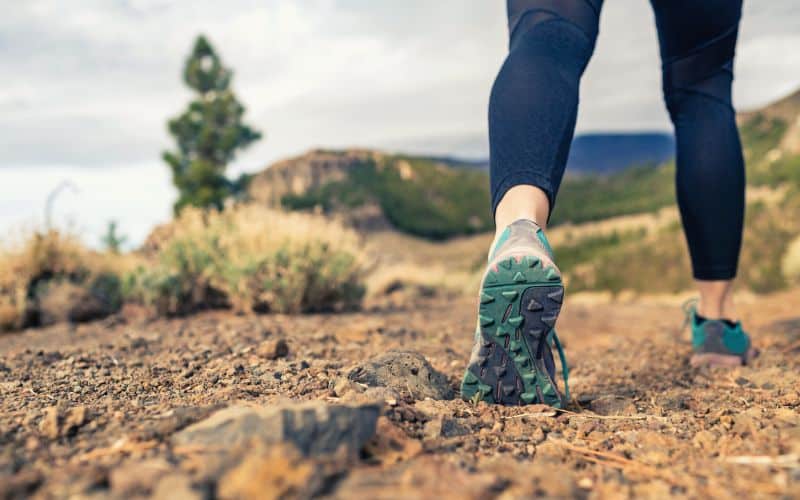
How To Choose The Best Hiking Tights
Comfort & Fit
Rise
This refers to the distance from the waistband to the seam of the crotch. Leggings are available in three types of rises – low, mid, and high. Low-rise models have the shortest distance between the waistband and the crotch, while high-rise models have the greatest distance.
While largely subjective and a matter of taste, there are benefits to each style. High-rise models provide added tummy support and coverage, reduce the risk of your backpack rubbing against your waistband, and are less likely to result in a muffin top(!). Mid- and low-rise models, on the other hand, are often favored in warmer weather because there’s less fabric around your midriff.
Waistband
In our experience, wide waistbands with a smooth and flat profile are the most comfortable and least likely to chafe or rub when you’re sweaty and wearing a backpack. Mesh-lined waistbands like those on the Eddie Bauer Trail Tight and Arc’teryx Essentl permit a little more airflow, so are great for hot-weather hikes.
Flat-Sewn Seams
These are seams in which the two edges of the fabric are sewn directly together instead of on top of each other (as is the case with regular seams). This reduces bulk and the risk of the seam digging into your skin or chafing.
The Fjallraven Abisko Trail Tight, REI Co-op Active Pursuits, prAna Electa, and Patagonia Pack Out Tights all use flat-sewn seams.
Material
Hiking leggings first became a thing when outdoor brands recognized that yoga pants, though often more comfortable than regular hiking pants, just won’t cut it on the trail.
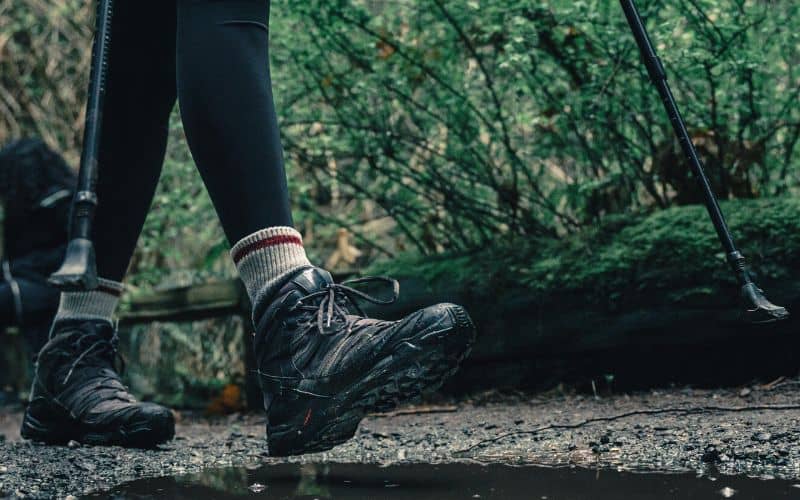
To provide you with all the comfort and mobility of yoga pants but enough ruggedness and durability to deal with the rigors of outdoor use, hiking leggings use a variety of materials. Below, we’ve added a brief overview of each type.
Elastane (aka Spandex or Lycra)
This is the fabric that gives a legging its stretch. The percentage of spandex used in the pants in our review ranges from 29% (Arc’teryx Essent) to 12% (Eddie Bauer Trail Tight and MH Chockstone). Those with a higher percentage typically provide more mobility.
Nylon
While less breathable than polyester, nylon offers more in the way of durability and abrasion resistance. The Fjallraven Abisko Trail Tight, Smartwool Merino Sport Fleece Tights, Arc’teryx Essent, and Mountain Hardwear Chockstone all use a high percentage of nylon in their construction and are among the most durable models on our list.
Polyester
This is highly breathable and has great moisture-wicking capabilities, but it is a little less durable and rugged than nylon.
Merino Wool
While pricey and not quite as durable as synthetics, merino’s a stellar performer in the outdoors. It’s naturally odor-resistant, high-wicking, breathable, and super soft to the touch.
Most merino tights include a high percentage of polyester/nylon and elastane to add durability and stretch, as with the Smartwool Merino Sport Tights.
Polyamide
Polyamide is less breathable than any of the other fabrics we mention but is usually a good option for cold-weather hikes because it’s both heat-retentive and water-resistant. If this sounds good to you, check out the Fjallraven Abisko Trekking Tights, which are made with 82% polyamide.
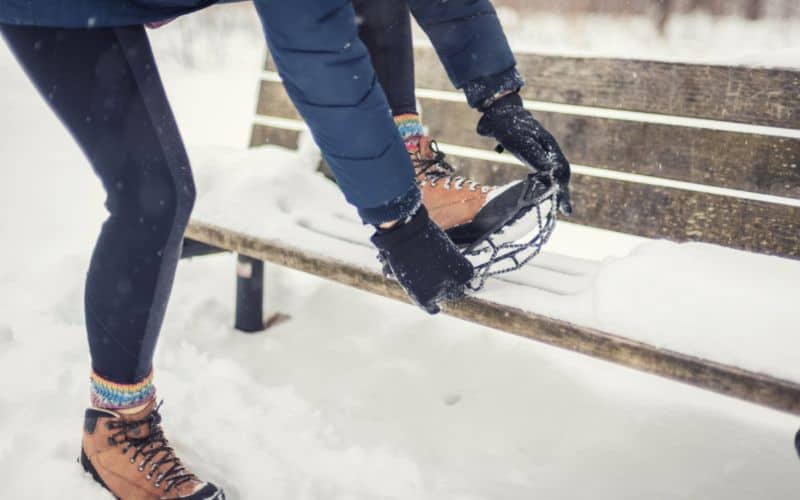
Mobility
A few features and design characteristics can vastly improve how easy it is to move on the trail. In addition to stretch in the fabric, the most important of these are a crotch gusset and articulated knees.
Gusseted Crotch
This is a diamond-shaped piece of material that connects the two pant legs in the groin area. The extra fabric provides unrestricted movement, especially when walking uphill. It’s also good for camel-toe avoidance (!).
Articulated Knees
Articulated Knee – An “articulated” knee is one with a pre-bent shape that conforms to the natural curve of your leg. This design provides a greater, freer range of motion when hiking or trail running and prevents the fabric from bunching up behind the knee.
Breathability & Moisture Wicking
Simply put, “breathable” and “high-wicking” fabrics are those that allow your sweat to escape from inside the legging to out, thus reducing the risk of saturation by perspiration. Saturation in itself isn’t a huge problem, just icky, but once a fabric becomes saturated it also breathes less efficiently compounding the problem.
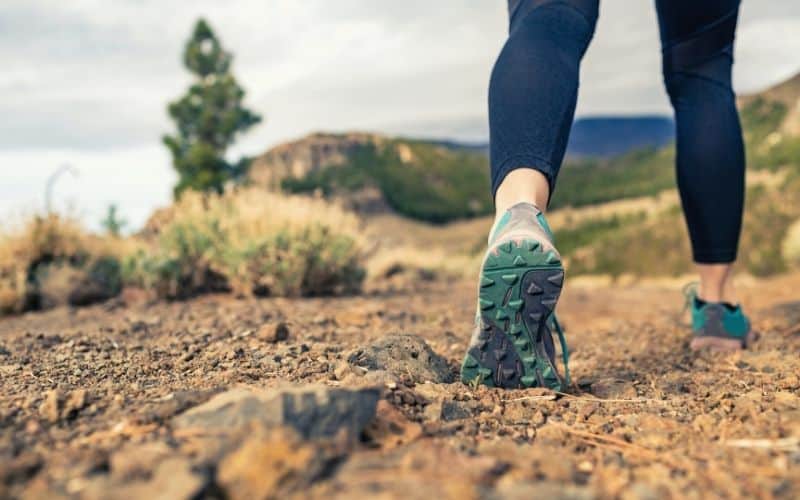
Most leggings for hiking place breathability at the forefront of their design. Because different models use different fabrics, however, the breathability they offer can vary significantly.
The most breathable models on our list are those made with polyester-spandex blends, while nylon-spandex and nylon-merino-spandex blends like the Smartwool Merino Sport Tights come a close second.
The least breathable are those made with polyamide and cotton. While cotton’s a highly breathable fabric, it soaks up sweat instead of wicking it and loses all breathability when wet. Pure cotton tights, then, are a definite no-go.
Our advice? If you go hiking in warmer climates or are more of a speedy strider than a stroller, try to get your hands on the most breathable model available. The Montane Ineo Pro, Patagonia Pack Out Tights, and Mountain Hardwear Chockstone all fit the bill.
Durability
While hiking leggings are typically a fraction less durable than your average hiking pants, the most recent models are closing the gap.
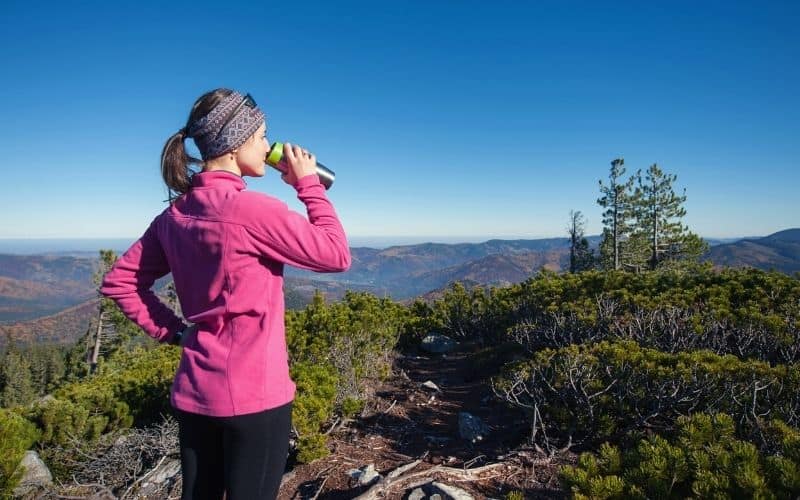
Needless to say, some models of legging are more durable than others. The most durable and rip-resistant are those made with a higher percentage of nylon or polyester, nylon being the tougher of the two. It’s also worth noting, though, that this increase in durability might cause a decrease in flexibility.
Reinforced Panels
Some brands use reinforcing patches on areas prone to abrasion, like the seat, knees, or inside the ankles. This provides added protection against any abrasives you might come into contact with on your hike.
Water & Weather-Resistance
Leggings are generally not as weather-resistant as traditional hiking pants, but some are coated with a Durable Water Repellent (DWR) treatment to add some water resistance. This treatment, in short, causes the water to bead up on the surface instead of saturating the fabric, and in most cases will see you through a short rain shower.
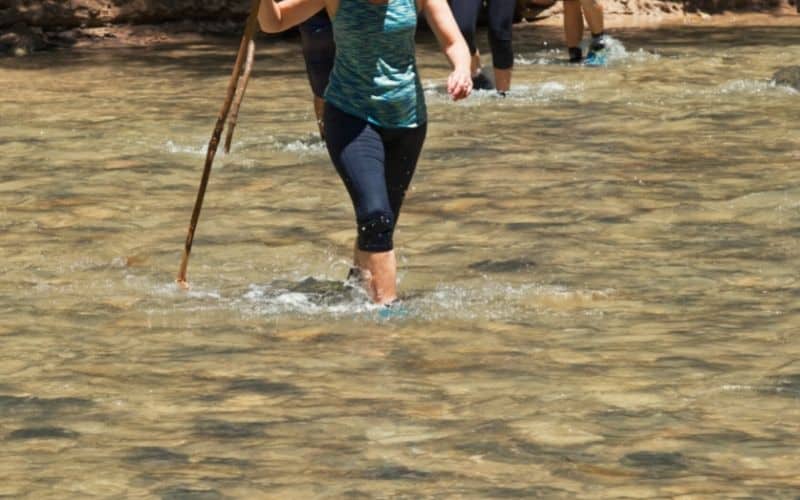
Traditional DWR treatments have come under scrutiny for their use of perfluorinated compounds (PFCs), which are linked to a range of environmental and health issues. These days, however, certain brands use treatments that are PFC-free, as with the DWRs in the Montane Women’s Ineo Pro Pants and Mountain Hardwear Chockstone Rock Tight.
While there are no genuinely waterproof leggings out there, the beauty of wearing leggings, of course, is that they also fit nicely under a pair of waterproof rain pants if the wet stuff starts falling a little harder.
Other Features To Consider
Pockets
Some leggings have pockets in the thigh area for easy access to small essentials whilst on the move – handy if you like to keep your keys, phone, compass, GPS, etc., close to hand. If you aren’t carrying a backpack, multiple pockets is the way to go.
Sun Protection
The ultraviolet protection factor (UPF) rating tells you how well any garment protects your skin from harmful UV rays. In hiking tights, UPF ratings range from around UPF 30 to 50+ (the highest rating available).
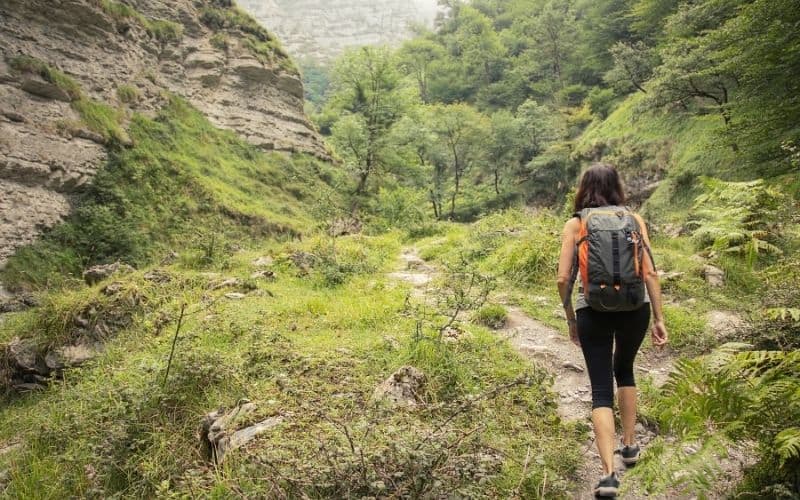
The most UV-resistant models on our list are the Fjallraven Abisko, REI Co-op Active Pursuits, Eddie Bauer Trail Tight, and MH Chockstone, which all have a UPF rating of 50/50+.
Reflective Tapes
These are high-vis patches or stripes used in some leggings, like the REI Co-Op Active Pursuits, to make you more visible to vehicles, especially at night.
Sustainability
If this is one of your priorities, look for recycled materials, PFC-free DWR treatments, and bluesign-approved fabric.
Best Hiking Leggings: The Verdict
Just in case you’re still undecided, let’s have a little recap to help you out.
After taking each of these tight for a spring on the trails, our standout favorites are the Fjallraven Abisko Trekking Tights. The Abisko were a pleasure to wear and do everything we need a pair of leggings for hiking to do. They’re mobile, comfortable, chafe-free, breathable, and made with moisture-wicking, durable fabric.
If you’re looking for a more affordable option, our pick of the best hiking leggings for buyers on a budget are the Eddie Bauer Trail Tight and REI Co-op Active Pursuits. Both are as comfortable as yoga pants but have trail-specific designs and features that make them awesome performers on hikes.
So, how did you like our article? If we missed any of your favorite hiking tights or you have any questions, let us know! And if you’d like to share this post with your friends, please do!
